2022 Week 3: Environment, Sustainability & Community Health
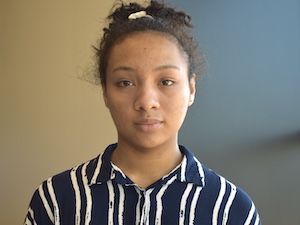 Angelica Brooks | Farm Alliance of Baltimore
Angelica Brooks | Farm Alliance of Baltimore
It is challenging to describe a typical day at work with my placement because you never know what a new day will bring. Last week, due to COVID concerns, the staff and I worked from home. However, every Friday, I visit the BBUFA (Black Butterfly Urban Farming Academy) Farm in Curtis Bay to work with the farming managers and trainees of the academy. I gather notes and images from Fridays and I help with social media posts every Wednesday. Most other days, when all the staff are healthy, I am working in the office, helping my supervisor Alison with any tasks or doing research for my own personal benefit. There are also meetings every month, where every urban farm comes together to discuss any updates, and the Farm Alliance will provide information that will affect all of the farms.
Because of the unpredictability, instead of “settling” into a routine, my interests are always peaked as I stay prepared to expect the unexpected. For example, this past Friday, I came to the farm with my only information being that I would help harvest garlic. Instead, my day exceeded my expectations. I harvested two large crates of garlic on my own, and the entire farm produced a quarter ton of garlic total. I made lots of good conversation with the farmer trainees; we sorted garlic into bunches of 10 while listening to Michael Jackson. After sorting the garlic, we used the generous space of a different farm (Oliver Community Farm) to hang the garlic against wooden ceiling structures. The garlic has to cure for 7-10 days before it is ready for sale. Furthermore, I met a man from my neighborhood (Cherry Hill) that recognized me and watched me grow up ever since I was a baby. The farm manager, Myeasha, gave me some harvested okra and I surprised my mom with it.
All of these experiences in a single day were a complete contrast from the remote work I did for days prior due to the small outbreak. However, both experiences were rewarding in different ways, and I am extremely grateful for all of the warm personalities I have met. I am so excited to meet more people in the future, and hope to establish meaningful connections that will last even after the internship ends.
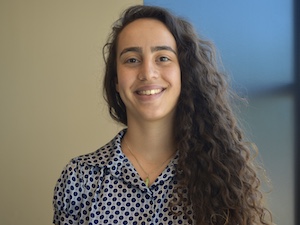 Siena DeFazio | Joy Wellness
Siena DeFazio | Joy Wellness
A typical day at my placement starts with biking to work. It is a pretty short and shady ride that I enjoy as a warm up for the day. Once I get in, I set up my stuff and make sure I did not miss any calls. While waiting for the usual morning calls coming from patients checking on classes for today, I make a cup of tea and relax. By the time 10 am rolls around, I start calling patients on the referral lists to recruit more participants for the center. Tuesdays I am on call for any technological assistance for the virtual nutrition appointments. Every other Tuesday I get to help out with our acupuncture class. My favorite class to help out with has been our life balance and weight management class. I have the most active roll there working with the patients to help track their weight and exercise hours. It is a sensitive subject for some and they are all dedicated to doing better, so I can see the sadness when they do not reach their goals. As someone interested in looking at health as a community endeavor, I think the class does a great job at turning that guilt that people feel from not holding up there goal into more motivation. They have created such a healthy supportive environment. In my head, a big part of this environment is the diversity of life stages that are in the group. A woman who lost 200 pounds can be there to support another woman who is struggling to lose 5 pounds. They all understand the differences between their bodies and no body looks to judge another for those distinctions. It makes me think that before any group can support individual change that group has be a welcoming environment.
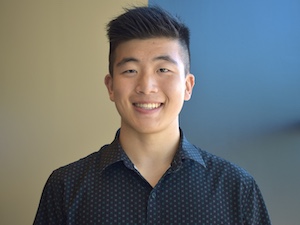 Jeremy Gu | Baltimore SquashWise
Jeremy Gu | Baltimore SquashWise
As we get closer and closer to having our Summer program kick off, I’m more excited than ever to start getting to know more of the Squashwise community. This week, I’ve started on more squash-facing activities such as stringing rackets and learning some basic squash exercises to give me a more in-depth scope of what Squashwise provides in terms of athletics. Because a large part of what i do at Squashwise has been things I’m familiar with, an interesting realization is that it’s so much easier to default to things I know how to do rather than the newer projects I’m tasked to do.
Squashwise’s new building has a ton of history that I was tasked with researching. It has been really interesting in learning the history here in Baltimore in the 1940s, but also extremely tiring. The project took me on a trip to the Building on Howard Street and visiting the Maryland center for History and Culture in finding more information. I was also able to access old archives for pictures of the building before to learn more about art deco architecture. This couple day project ended up taking me a whole week to do just because this history type of project was completely new to me. I took many breaks from working on the project with some office jobs, stringing rackets, and playing squash: these activities were way more simple to me and felt more productive on a minute to minute basis. This is a bias I need to keep in mind since all the work we have to do at SquashWise is important. They are an academic, squash focused staff, but the director is also working on a building acquisition and figuring out how to open up the announcement to the public. So even the staff is working on a whole array of things that are probably outside of all their areas of expertise. Knowing these help me focus and make sure I’m producing high quality work even when the scope is out of my familiarity.
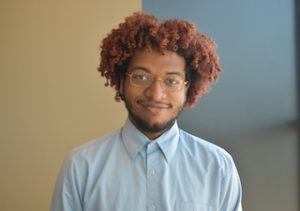 Brahein Richardson | Black Church Food Security Network
Brahein Richardson | Black Church Food Security Network
A typical day at my placement can be very calm for the most part, except days when I have to attend a plethora of meetings. On most days I wake up between 8am and 9am and do most of the morning routine things, go to the bathroom, wash my face, brush my teeth, take a shower, eat, etc. I work from home, so I am pretty comfortable in my space (which is really important for me) and I do not have to rush to be off somewhere. Then sometime between 9am and 10am or after, I have a quick zoom meeting or phone call with my site supervisor and we discuss the tasks for the day. On most days, my tasks include sending out a bunch of emails to people or other organizations we are trying to connect with in order to schedule zoom meetings. When we do have meetings to attend, my supervisor does most of the talking and I take notes during the meeting so we can reflect afterwards and continue having progressive conversations. Additionally, I have been working on designing some social media posts for BCFSN that can go up consistently. We have also started to brainstorm ideas for a potential TikTok account. Transitioning to another note, someone who inspires me at my place is for sure thee Reverend Dr. Heber Brown III. He is absolutely and thoroughly invested in the Black Church Food Security, and the goal of branching out food sovereignty in black communities across the nation. He has confidence and faith that seems to be truly unwavering. There is no idea or goal that seems too big for him, and he has honestly inspired me to pick back up some dreams that I told myself were not realistic. He is also unquestionably hilarious and I admire that so much because I enjoy a good laugh.
Since I’ve already talked about the projects I’m working virtually on in my previous blog posts, in this post I’ll describe a non-typical day in my life at work. This week on Wednesday and Thursday, we had an orientation in preparation for a summer program called Rise Up Ride Out that is starting next Tuesday. Rise Up Ride Out (RURO) is a collaboration between MissionFit and two other youth health and wellness nonprofits, BYKE and Corner Team. Orientation on Tuesday began with lunch, where I got to talk to Rebecca who is interning with Corner Team! Then we played a really cool icebreaker game that got everybody laughing. There were about 20 of us, and we all formed a large circle. After each person said their name and pronouns, they would come up with a new step to add to the group handshake. Then they would perform the handshake, including all the steps added by everyone in line before them, with the person on their left. By the end of the circle, we had a pretty lengthy, unique-looking handshake. It’ll be funny to see if we can remember all the steps when we reconvene throughout the summer!
Next, after about an hour or so of discussion about the schedule, safety precautions, and what we can expect from the kids this summer, we went outside again to play games. I have to say, this was probably the highlight of my week! I really enjoyed myself. We played games such as Ninja and a variation of red light green light called Jewelry Thief that emphasized communication and team-building. It was really similar to red light green light except that the person calling the cues had a huge cardboard box in front of her. The object of the game was for the rest of us to work together to try and get the box from her and bring it back to our side of the yard. Here’s the catch: whenever she yelled “stop” we all had to freeze, and if she could see the box when she turned around, we had to start over. Naturally, on the first try, it was every man for themselves. Everybody sprinted ahead and tried to get the box and bring it back themselves. We quickly realized this wasn’t going to work as the box was really wide and no one person could conceal it by themselves while carrying it back to our side. So we came up with somewhat of a strategy: we formed 3 slightly chaotic lines, standing side by side. The people in the first line would run out ahead and grab the box, and the second and third lines would space themselves out so that the people in the first line could pass the box back. Every time the person calling the cues would yell “stop,” we would all turn our backs to her and freeze. Since we were standing side by side, we had built somewhat of a wall around the box so she couldn’t see it. Quickly enough (on the second or third try), we got the box back to our side. It was really cool to see the communication and teamwork throughout the game, and everybody laughing and smiling after we had figured it out. I definitely got to see the RURO curriculum come to life through these games. The RURO curriculum focuses on the acronym GRIPS (Grit, Respect, Integrity, Peace-making, and Scholarship). After each game, we discussed the themes in the acronym that we felt had emerged in the game; for instance, grit when we had to try 3 or 4 times to achieve the object of the game.
It was really amazing to see how movement-based games helped to break down walls between all of us (the shyness and awkwardness that always persists in the beginning when people are getting to know each other) and fostered a sense of community. The collective energy of the group was incredible!
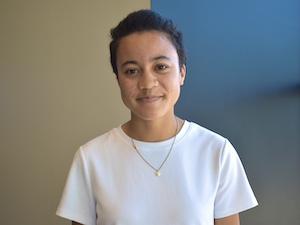 Marisa Thomas | Whitelock Community Farm
Marisa Thomas | Whitelock Community Farm
A typical day for me at Whitelock usually starts with a walk from my apartment to the farm. Once I get there, we usually start with unlocking the shed and cooler and opening up the hoop house. In the mornings, we usually do any necessary cleaning and watering. Sometimes we clean the shed, other times we clean tarps, and other times we pick up trash. As the day progresses we start weeding and preparing rows for new crops. Once that’s completed, we actually plant the crops. Not all of these things are completed everyday, the specific tasks really depend on our agenda for the week. On the virtual side, we’re prepare for upcoming events, record harvest data, record volunteer information, and keep records of expenses. The virtual tasks get completed at home after the work on the farm. In the beginning, we were spending more hours doing physical farm tasks, but now we’ve transitioned to a combination. We probably spend around 5 hours a day on the farm and 2 hours doing virtual work. I usually don’t have to attend as many meetings as my supervisor, so I have more time to work on some of the forms and spreadsheets. Monday through Thursday we usually focus on farm related tasks and virtual work while Fridays are harvest days and Saturdays are selling days.
This past week was a little more eventful than usual. On Monday, there was a big storm earlier around noon, which cut down our time on the farm that day. We had a phone conversation about a lot of the virtual work I could do and also discussed some of the challenges and motivations behind urban farming. Ms. Kim recommended a few books I could read and actually lent me one to start reading called Farming While Black: Soul Fire Farm’s Practical Guide to Liberation on the Land by Leah Penniman. On Tuesday, we had a vermiculture workshop, which taught people how to use worms to make compost. By Wednesday, built up exhaustion from previous weeks in combination with the heat made us feel sluggish, but on Thursday we had volunteers in the morning and got a lot of things done. Friday was harvest day, which is one of my favorite days of the week, and we prepared all the CSA orders for pickup Saturday. This week, I was able to harvest the dino kale faster than last time, and I also realized that my plant identification skills were improving!
One of the best parts of the week is when community members come to the farm to chat. Besides the vermiculture workshop, we probably got to talk to over ten different people who came by to talk about their days or help out. Usually we get to see other people in the Baltimore farming community, and this week was no different. Many of them came on Tuesday to attend the workshop and help out on the farm. Another community member introduced herself and signed up for the CSA. Still another came to talk about struggles with his own plot in the neighboring community garden. I love getting to see so many different people at the farm, and it feels good to know that people are really connected to the work being done at Whitelock.

